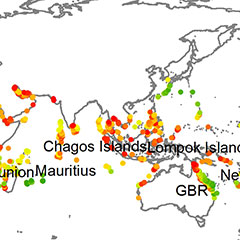
A comprehensive map of the world’s corals and their exposure to stress factors, including high temperatures, ultra-violet radiation, weather systems, sedimentation, as well as stress-reducing factors such as temperature variability and tidal dynamics, has been created by MacArthur grantee the Wildlife Conservation Society and other groups. Using an array of publicly available data sets from satellites and a branch of mathematics known as fuzzy logic, which can handle incomplete data on coral physiology and coral-environment interactions, the researchers grouped the world’s tropical coral reef systems into clusters based on the sum of their stress exposure grades and the factors that reinforce and reduce these stresses.
Data from the report will be used to conserve some of the world’s most important coral reefs by identifying reef systems where biodiversity is high and stress is low, and ecosystems where management has the best chance of success. Researchers also recommend formulating management strategies that would include activities such as fishing restrictions, the management of watersheds through improved agricultural practices, and reforestation of coastal watersheds that play a role in healthy coral systems.




